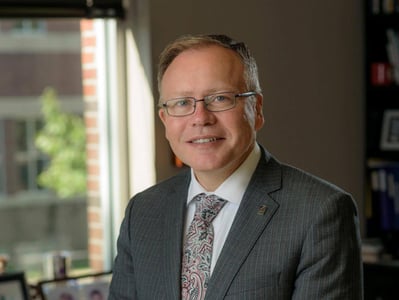
September 14 2022
A president once told our planning team during a strategic planning kickoff meeting, “We all know that we can sit here and in a half-day come up with our top strategic goals—but that would do no good.”
Why?
“No one else would know, no one else would be in the conversation,” the president continued, “and it wouldn’t accomplish what we actually need.”
In a handful of words, this president summed up one of the most important building blocks of successful strategic planning: You must have authentic, whole-community engagement. The traditional model of strategic planning—in which an organization’s leadership develops, approves, and dictates a plan to employees—often ends up in a well-intentioned document that’s difficult to implement. That’s because the people tasked with doing the work—the administrators, middle talent, faculty, and/or staff—don’t have a say in the tactics prescribed to meet the plan’s goals.
Authentic, whole-community engagement is essential not only in allowing employee voices to be heard but also ensuring the institution takes achievable paths toward the goals leadership has set. Whole-community engagement isn’t a quick process, nor is it easy to do in a way that makes each employee feel valued rather than tokenized. At Credo, we’ve helped more than 200 institutions successfully navigate this challenging endeavor.
Keep reading to learn five important yet practical ways for leaders to authentically engage community in strategic planning.
Ask organizational leaders to set the strategic goals—then stop.
An institution’s president or CEO, cabinet, and board are accountable for the health and welfare of their institution. They also have the most expansive, bird’s-eye view of the organization and the opportunities and threats it faces. Therefore, they’re well-equipped to develop broad goals that can help the institution advance in a sustainable way. Once those goals are created, however, it’s time for leadership to take a back seat and turn the reins over to their people.
Prepare organizational leaders for feedback.
At this point, a lot of leaders push back: Wouldn’t it be faster to work with a small group of stakeholders to get the plan done? In theory, yes. But if their goal is to understand what the institution actually needs—not just what its leaders think it does—then robust community engagement is vital. In every leadership kickoff meeting, we’ll ask the president or CEO, “Are you ready for your community to tell you what they see and what they want?” If their answer is “yes,” then they’re ready for a transformative strategic planning process.
Invite everyone (and we mean everyone) to participate.
Administrative assistants. Department chairs. Environmental services workers. Admissions officers. Everyone who’s a part of your organization should be invited to weigh in on the broad goals your leadership has outlined for the strategic plan. Our Credo team works with our partners to create a unique, full-day event to facilitate this type of engagement. Most employees—especially those at colleges and universities—are rarely, if ever, asked what they think their organization’s future should look like. Engaging them in this event is a tangible way to illustrate to these employees that they are valued, and they respond to that invitation enthusiastically.
Keep your feedback requests as broad as possible.
Credo strategic planners help lead these community-wide discussions, and we intentionally keep the conversation at a high level of abstraction. For example, let’s say one of a university’s goals is to streamline its degree offerings. We wouldn’t start with a specific question such as, “Next semester, should we offer chemistry or physics?” Instead, we would ask a more open-ended question: “What academic programs do you believe are strongest at our university?” This encourages a broader range of answers. Our Credo team then organizes employees’ responses into categories that can be mapped to the strategic plan’s broad goals.
Make community engagement a priority throughout the entire strategy process.
It’s important that an organization develops a consistent communication plan to keep all employees informed on the progress of the strategic plan. We also work with our partners to identify and recruit employees interested in further engagement via the committees and task forces that will flesh out the strategic plan’s tactics. The goal is to bring as many members of their community together as possible, particularly people who don’t typically have a chance to engage with one another in their day-jobs. This allows us to work through opportunities and challenges from all angles—because you never know where a brilliant idea will arise.
At Credo, we know that authentic, whole-community engagement can be a heavy lift for organizations already spread thin, staff-wise. Yet we also know it’s indispensable if an institution wants to create a strategic plan that achieves tangible, meaningful results. That’s why we take on the bulk of the logistics for community engagement—the invitations, event management, facilitation, and data collection and analysis. This allows our partners to focus fully on their people and the ideas they bring to the table.
Interested in learning more about what it’s like to embark on a strategic plan with Credo in your corner? Find out what our strategic planning clients say about involving the community and setting a plan in motion together.
Ready to talk planning? Schedule a complimentary 30-minute session with Credo about Strategic Planning & Implementation.
Related Blog Posts
Recent Posts
- Richard Dunsworth, J.D., To Receive 12th Annual Courageous Leadership Award December 16 2024
- Meet the 2024 Credo Values Award Recipients August 27 2024
- What is Executive Coaching, Really? June 25 2024
- Credo & The Constructive Dialogue Institute Announce A New Partnership For Higher Education Leadership Development March 7 2024
- Celebrating Women And Gender-Diverse Learners & Leaders February 28 2024
Categories
- Strategy
- Leadership
- Student Success
- Student Success & Retention
- Enrollment
- Pivot
- Strategic Planning
- Leadership Development
- News
- Strategic Enrollment
- Campus Planning and Architecture
- Moving the Needle
- Data
- Research
- Retention
- Campus Master Planning
- Enrollment & Financial Aid
- Academic Programming
- Campus Planning
- Thriving
- Admitted Student Research
- Architecture
- Finance
- Advising
- Admissions




